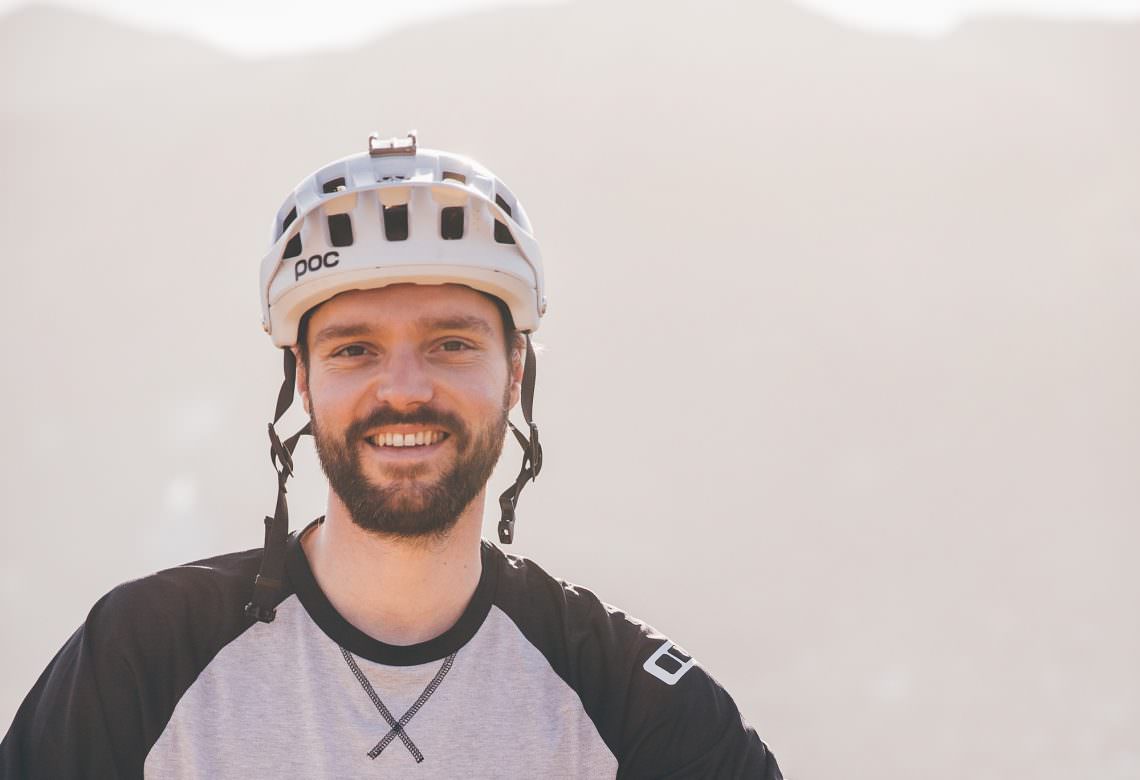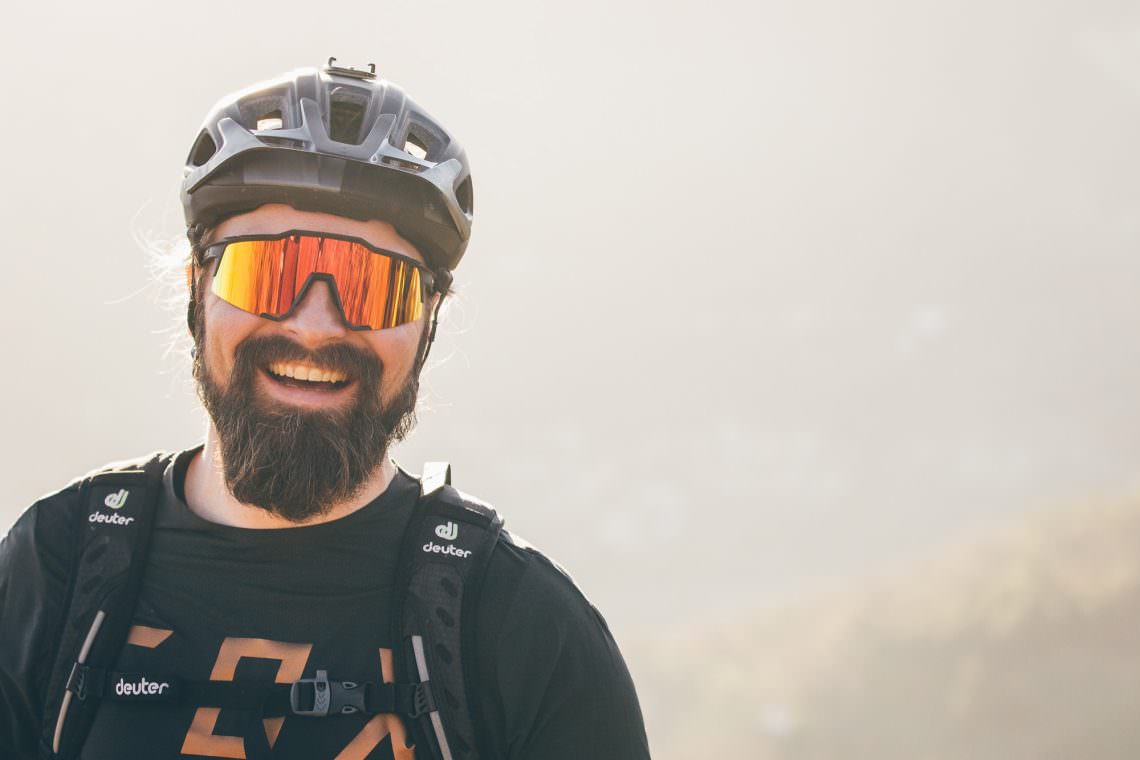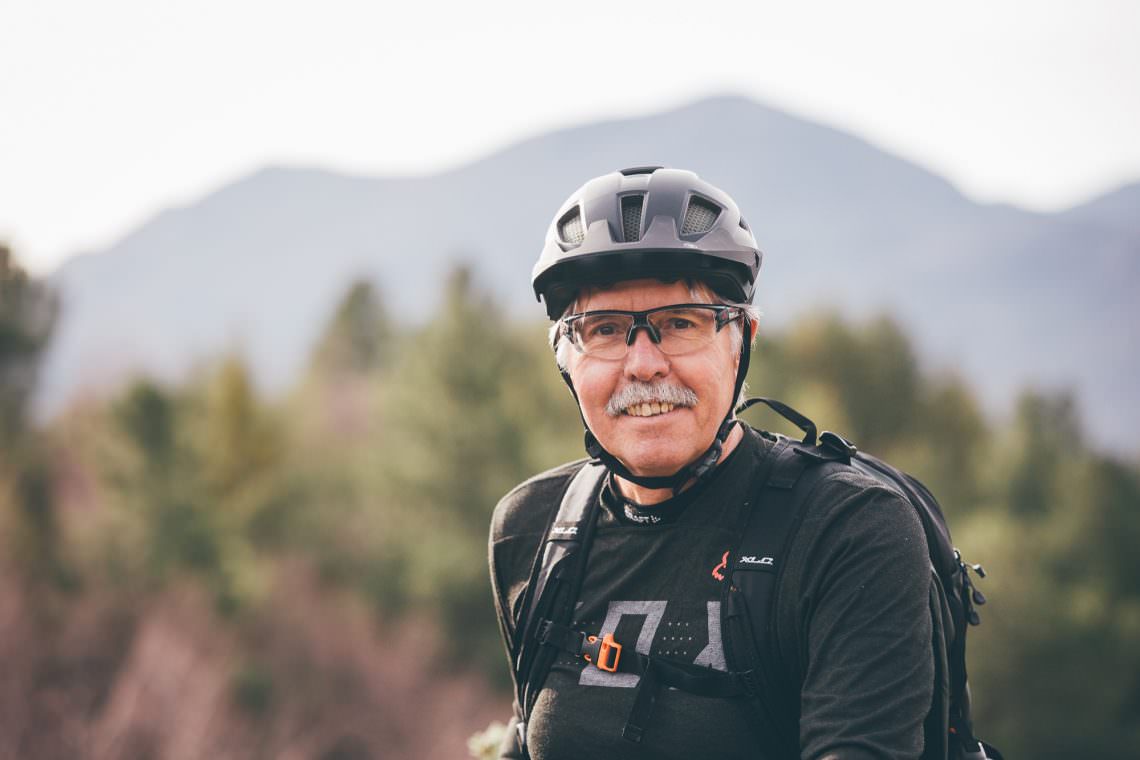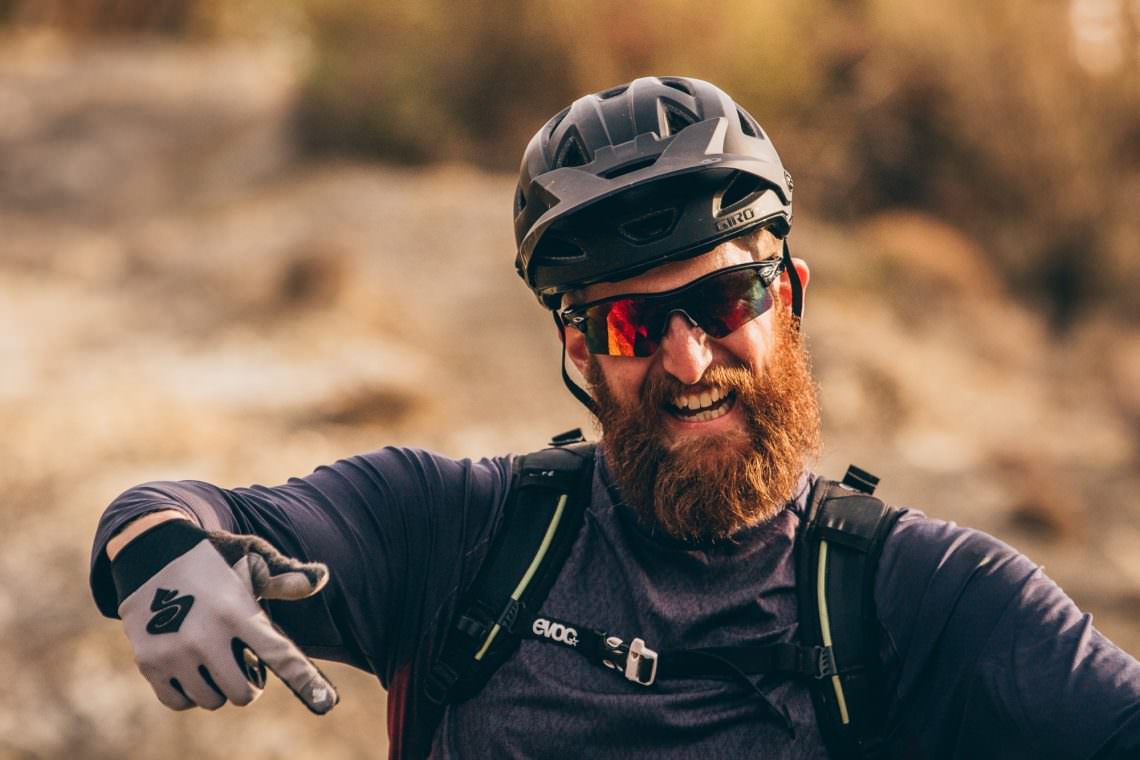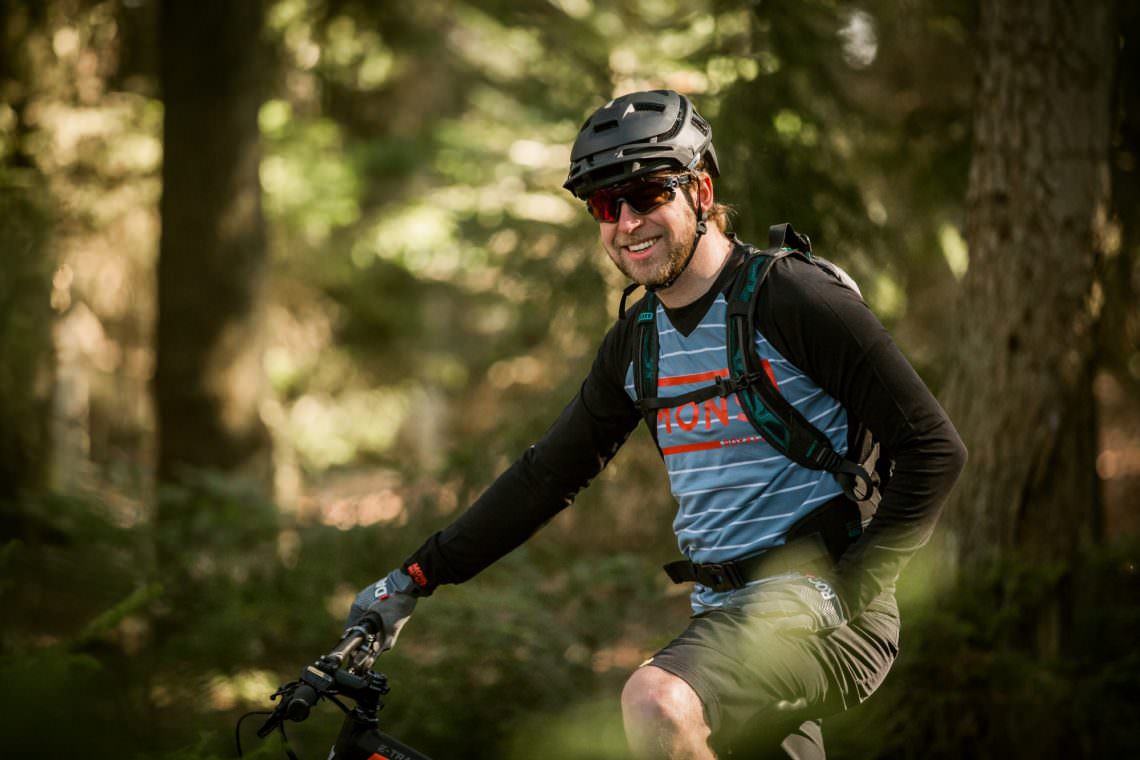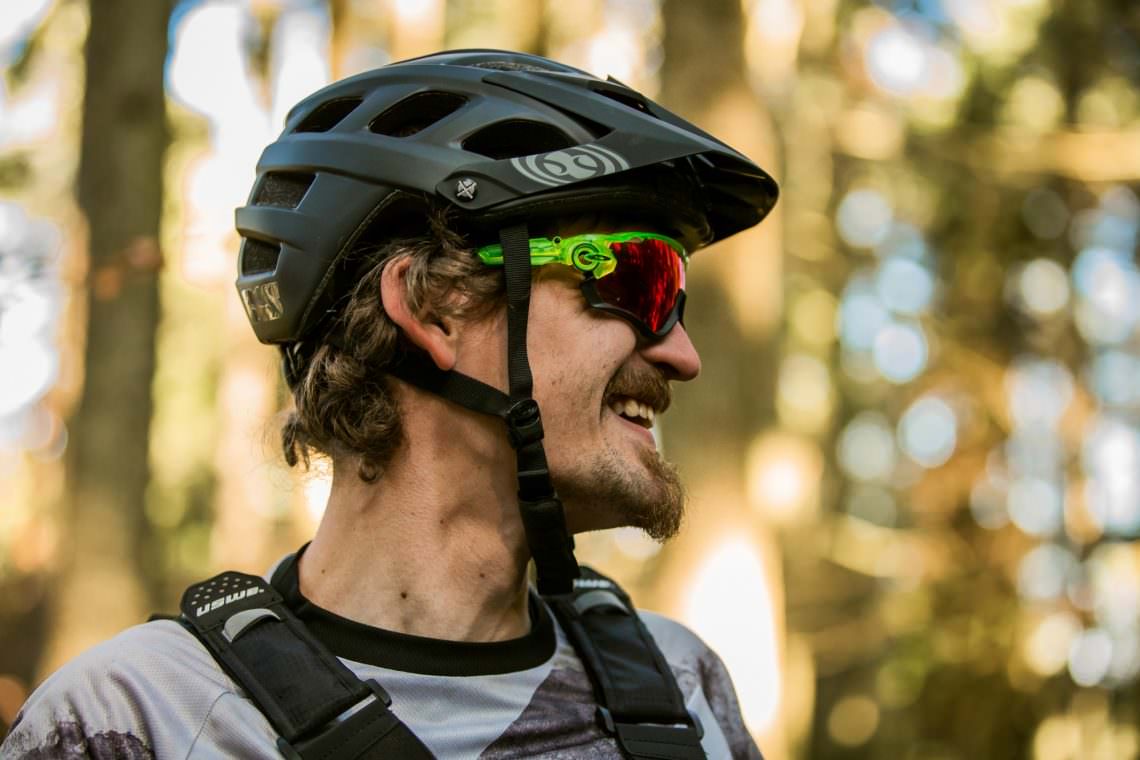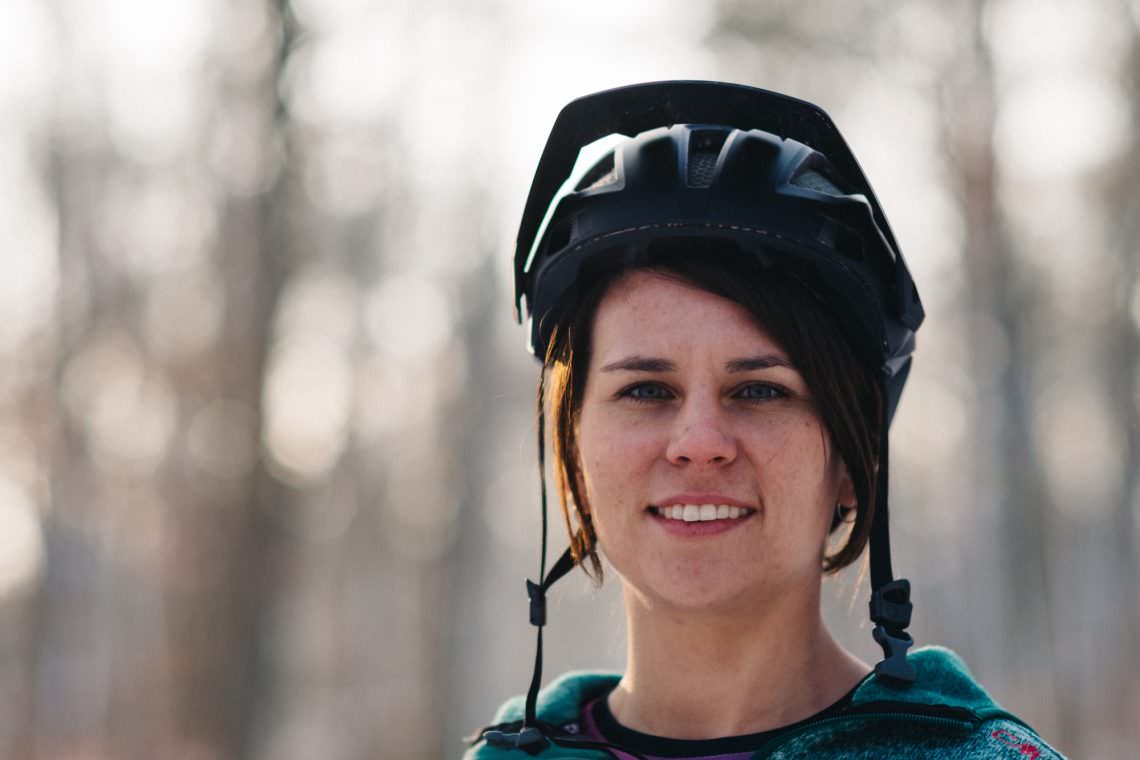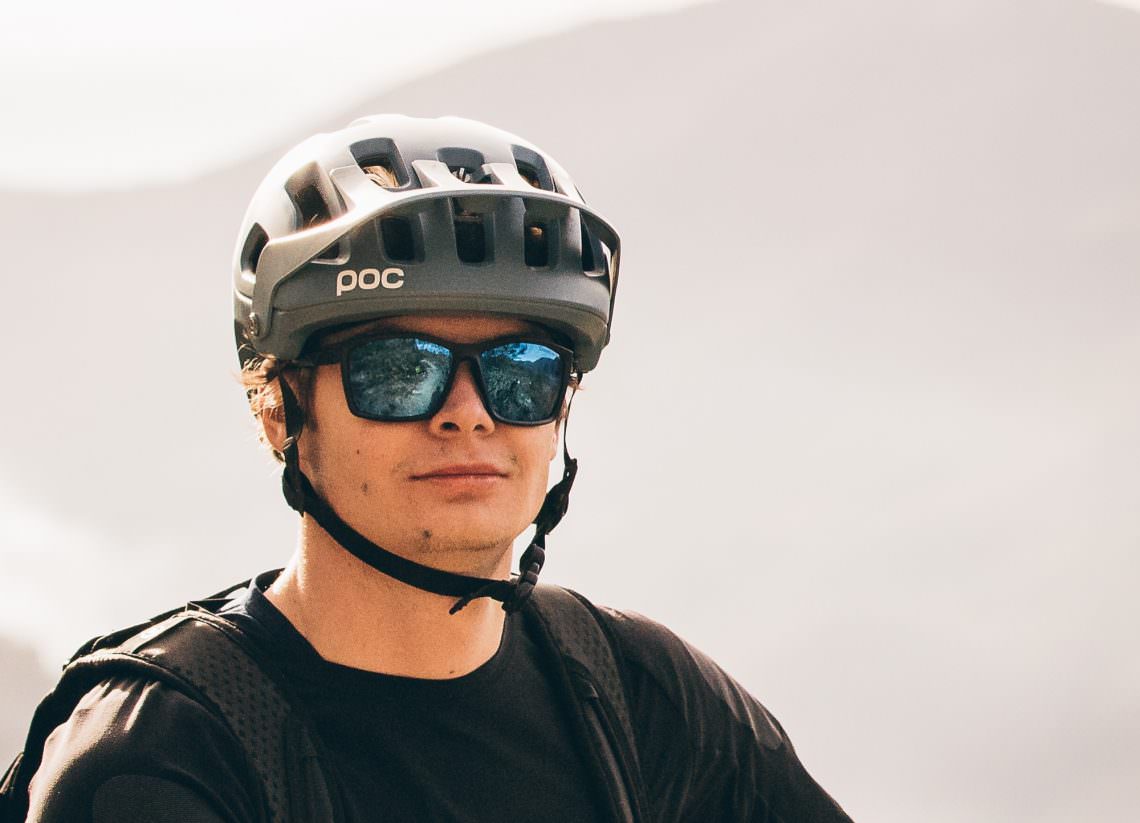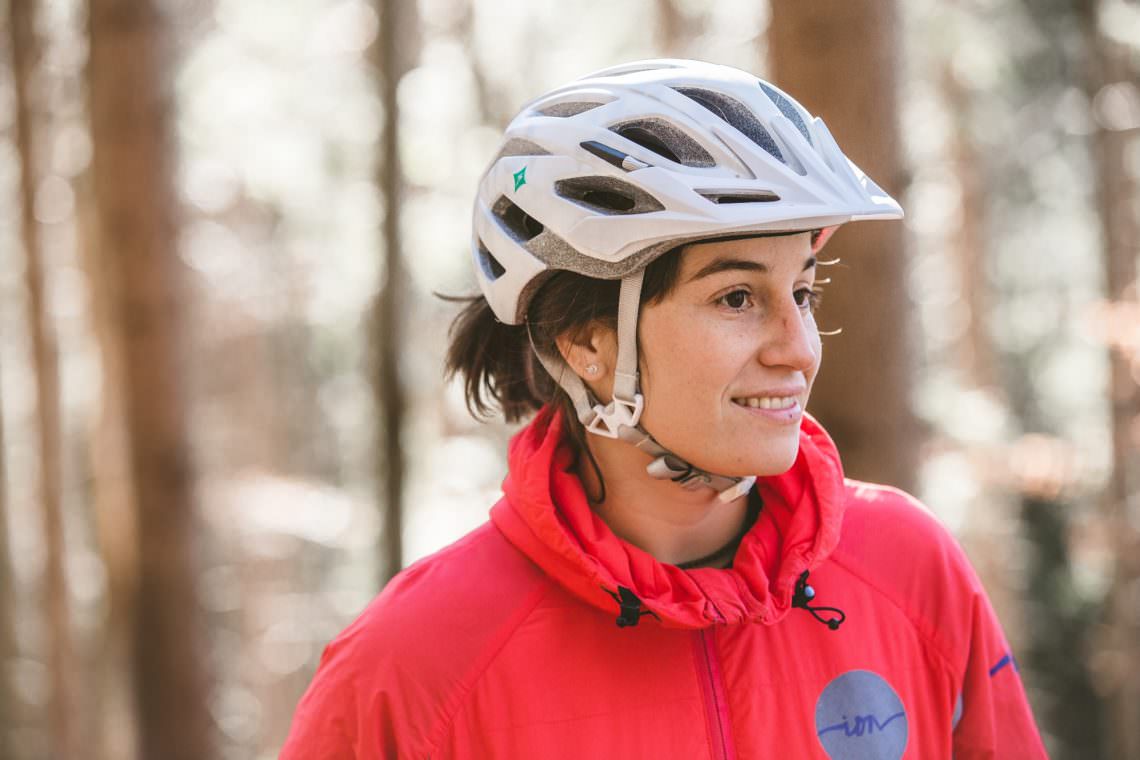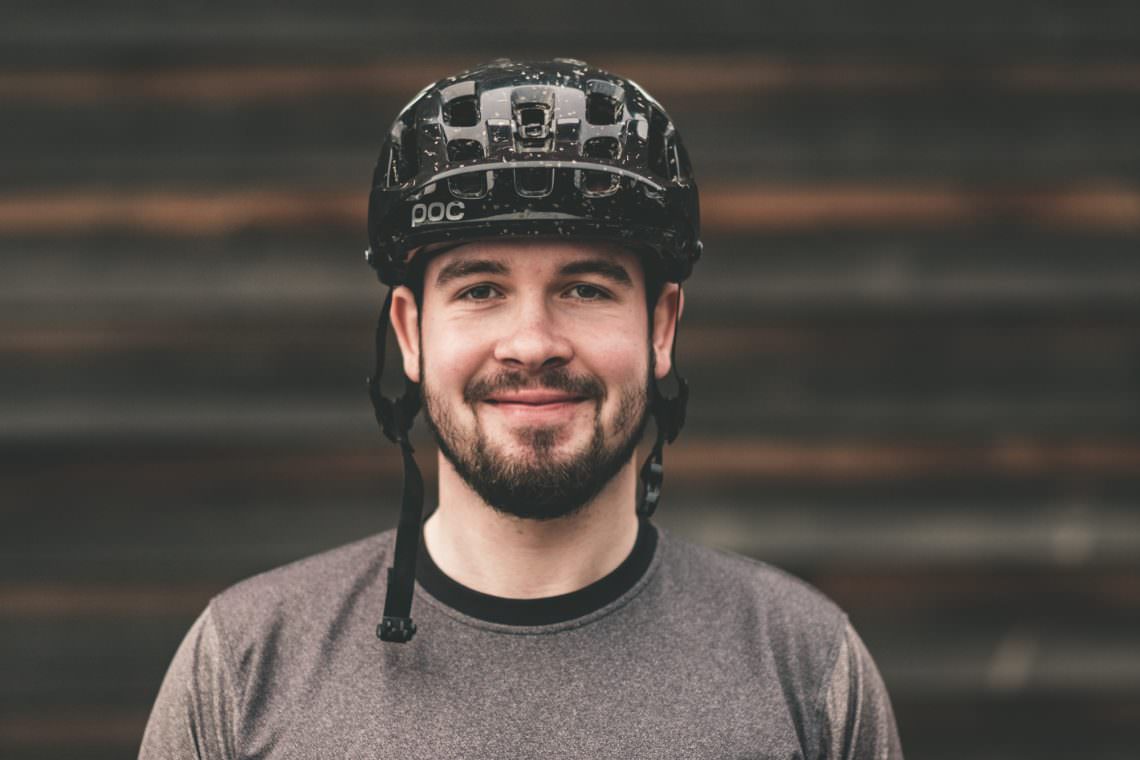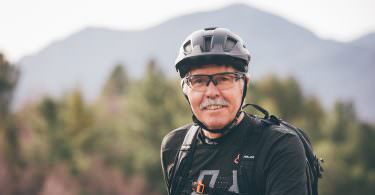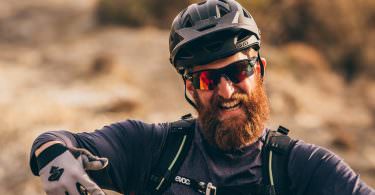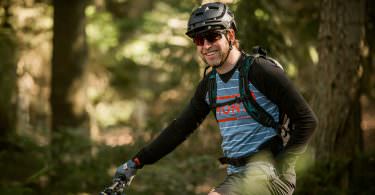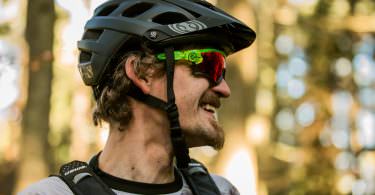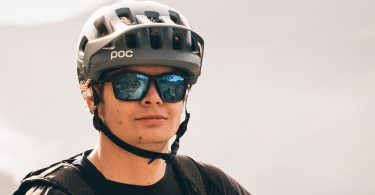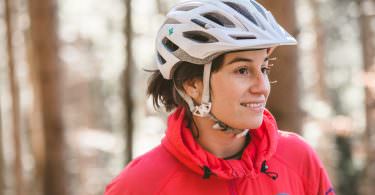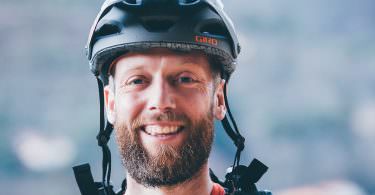Which is the best eMTB of 2018? We headed to the south of France to ride and review twenty-five of 2018’s most exciting new bikes. We divided the test field into two price classes – in this edition, we present to you eleven of the most affordable models, retailing for around € 4,500 each. The main question: How much should you budget for a good eMTB? This group test shows that € 4,600 is enough! But if you’re not careful, you’ll be paying the price later.
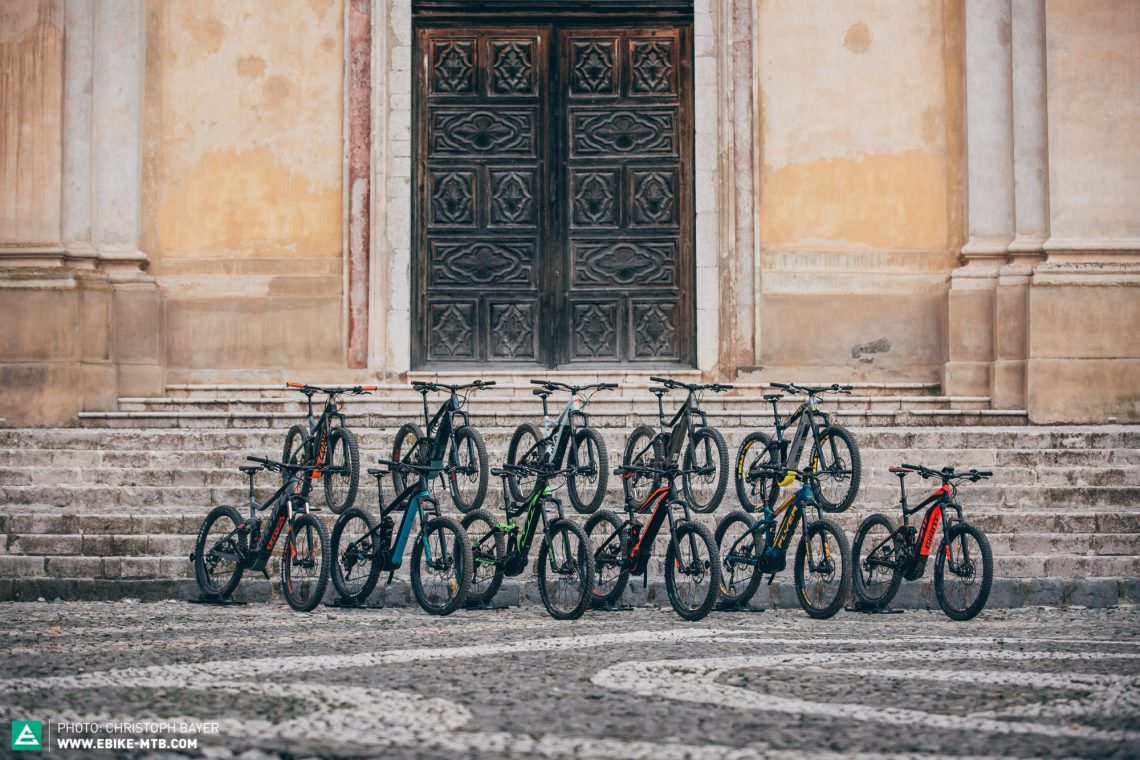
Before we get to the bikes in this group test, we would like to tell you something about our test procedure, the test riders, and some of the insights we gleaned in the process. If you’ve read the high-end eMTB group test in our last issue, you will be familiar with a lot of this already. So if you’d like to, feel free to skip ahead to the conclusion of the best affordable bikes further below and don’t miss the detailed individual reports of each bike.
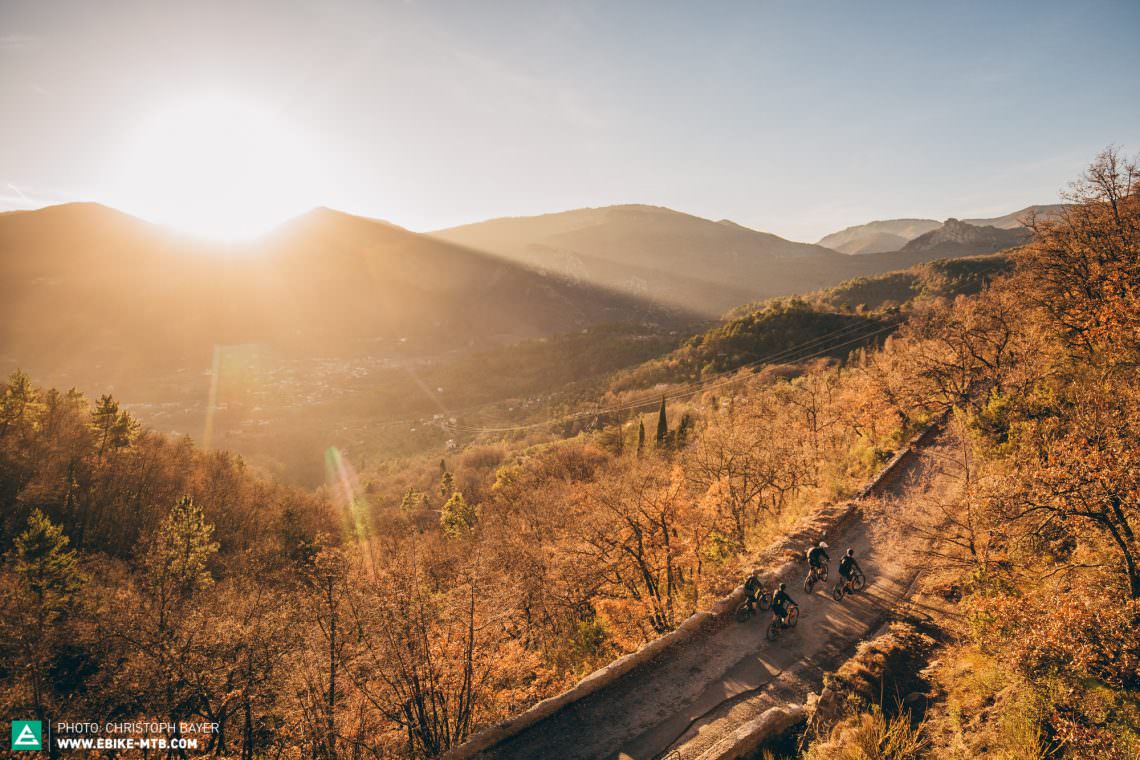


How and where were the bikes tested?
Our twelve-person test team not only tested the most exciting eMTBs of the 2018 season in the cold German winter, but also took them to the south of France for two weeks (we will spare you the mandatory muddy photos at this point). We climbed to the top of peaks, rummaged through deep mud, rode over countless roots and ruts on the way up and even more on the way back down, laughed, cursed, lived through many unforgettable moments, and took the bikes – and sometimes ourselves – to the limit.
In order to make the final judgement of every bike as objective as possible, the test team includes ex-racers and engineers as well as amateur riders and eMTB newbies. Even if we explored the bikes’ performance on the trail to the limit, we attach as much importance to their everyday usability. A potent and balanced bike which shines on demanding singletrack and is fun to ride should ride just as well on more moderate trails. And even if you’re not taking yourself and your bike to the limit every time you ride, it’s good to know that the bike is prepared for any situation you might feel like throwing at it.
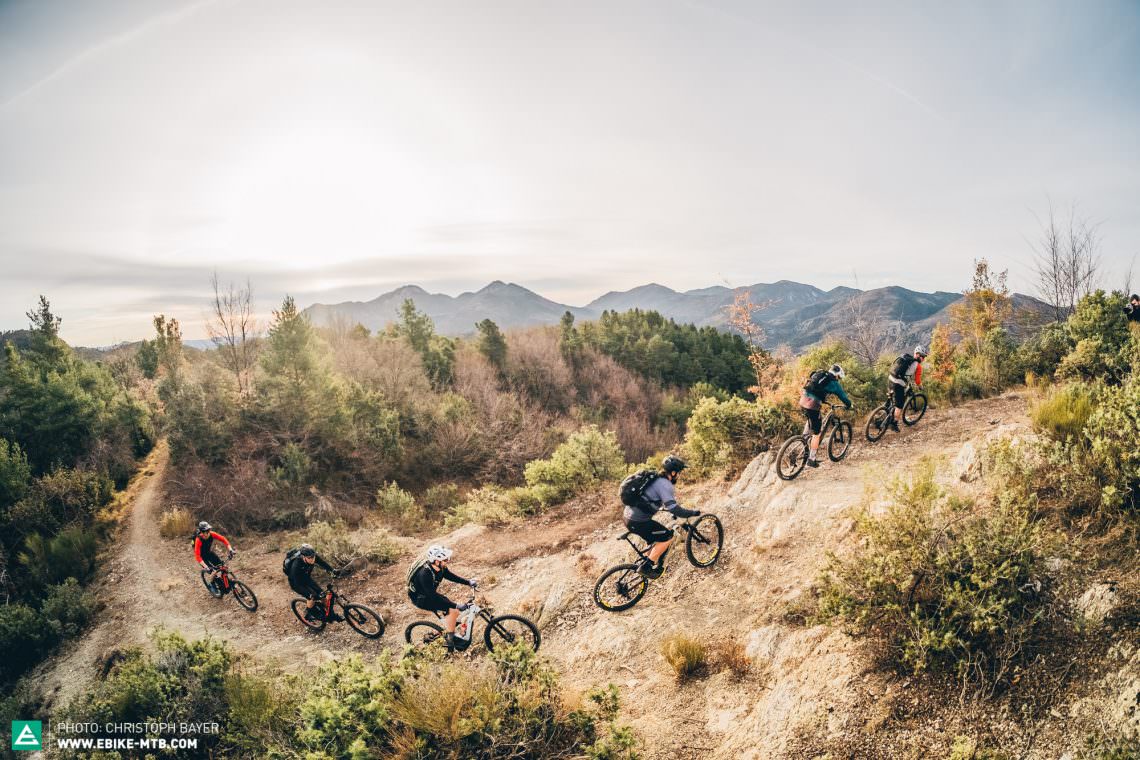
Extensive tours, rough trails, relaxed gravel rides – eleven affordable and exciting new ebikes had to assert themselves in a variety of conditions.
The test team
What makes a good eMTB? We asked our multifaceted test team what they thought is important for which type of riding.
“Winding down, spending time in the outdoors with friends without stress – nowadays, as an ex-racer, a reliable and low-maintenance bike with great handling is important to me. I want to have a lot of fun and spend as little time as possible in the workshop.”
The rating – why school grades are pointless
eMTBs appeal to a very broad audience, so in practice, the same model is used in very different ways. A final rating according to school grades does not do justice to the individual character of the bikes and doesn’t provide a sufficient system of orientation for new buyers (which is exactly what we aim to do). For this reason, there is a separate article for each bike in the group test; in each article we detail the most important points, informing you comprehensively about the bike’s strengths and weaknesses and the ideal type of riding it is suited for. We also have five-star ratings, which provide condensed snippets of information about the character of the bike for a quick and easy overview.
The Best in Test and Best Value tips do not result from the sum of star ratings, but by the assessment of the entire test team, taking into account the overall concept of the bike. It would be methodologically wrong to only add up the star ratings to make a final judgment in a scoring system – saying that something is “good” will not help anyone if they don’t know what it is for and for whom it is “good.” For this reason, we give a clear recommendation in every test result for which type of rider and purpose the bike is suitable and which not. The bikes themselves are as individual as the riders are – we just want to provide you with all the information you need to make a well-informed decision before buying. Here’s to long-lasting fun!
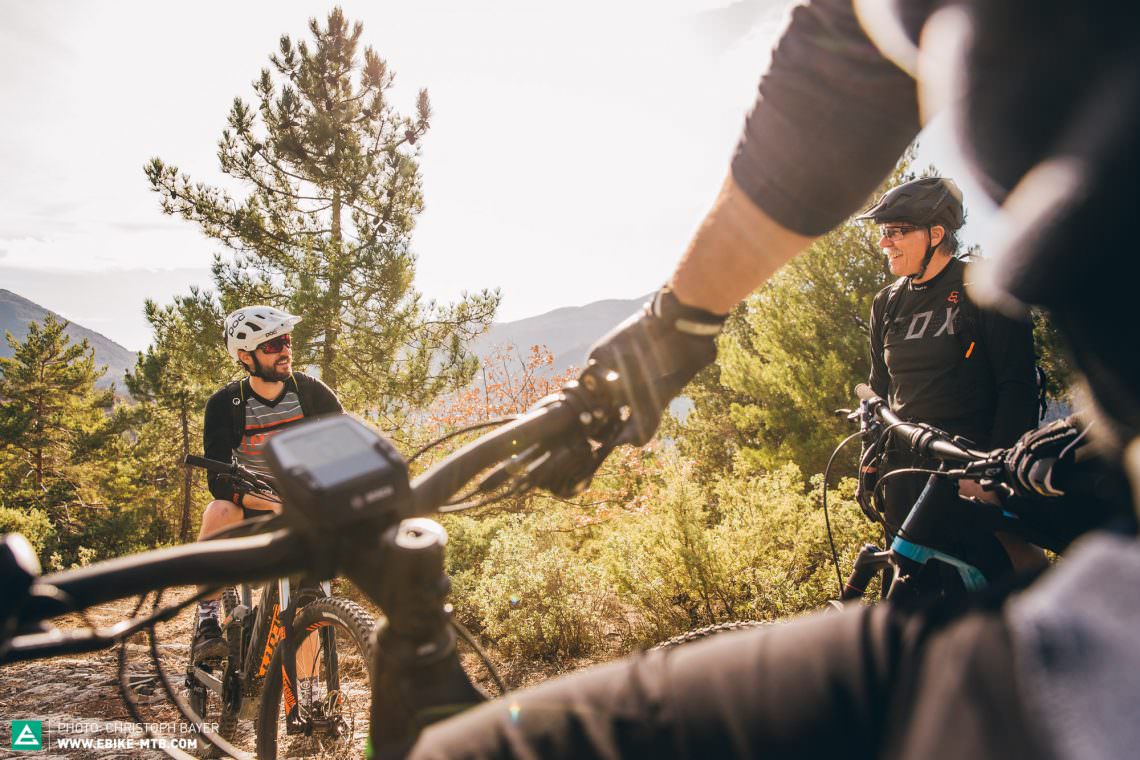

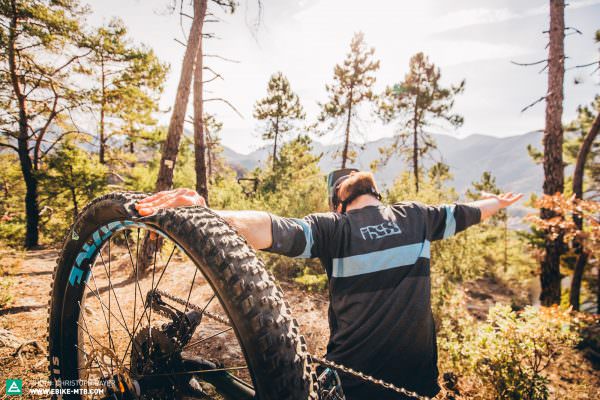
This is what makes a good eMTB!
A good eMTB is more than the sum of its parts. Fear not: we will show you what to look out for regarding the most important components.
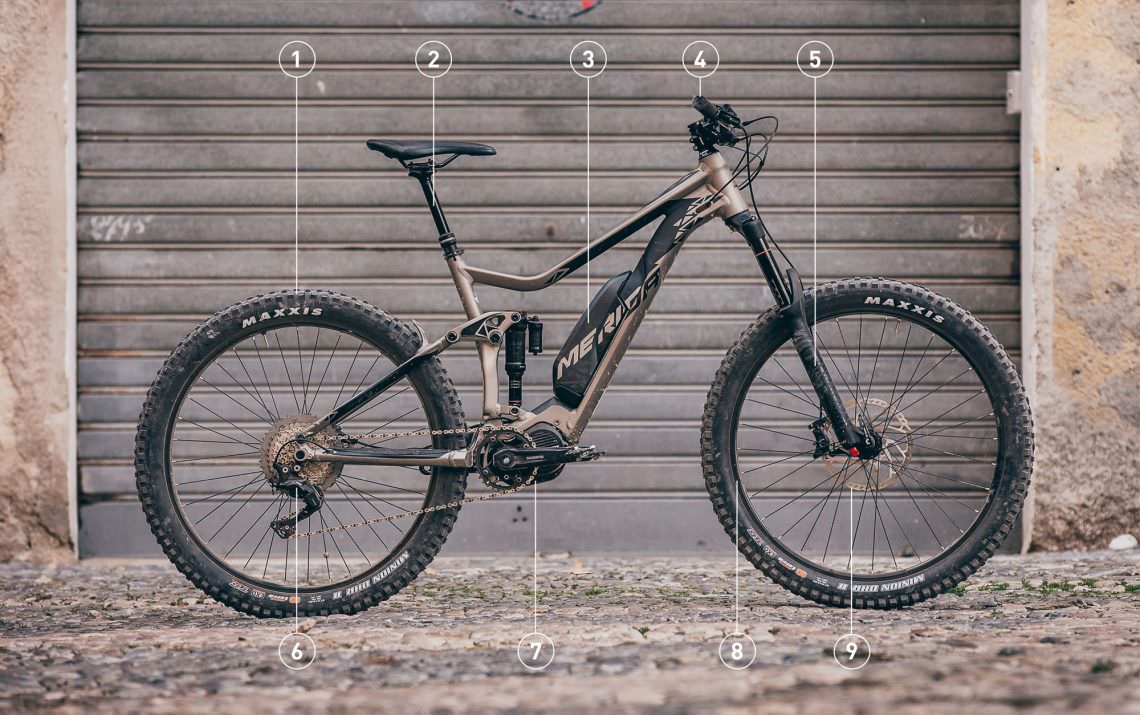
1. Tires
Rolling resistance doesn’t play a major role on eMTBs. Grip, puncture protection, and comfort are a lot more important. With a tubeless setup, puncture protection and grip can be increased.
2. Dropper seatpost
A dropper seatpost increases riding safety and fun immensely. It should have a remote on the handlebar and an adequate stroke length. This is especially important for riders with very short legs (who may need 100 mm stroke) or long legs (at least 150 mm stroke recommended).
3. Battery
Integrated batteries ensure a tidy look and often make it possible to mount a bottle cage. However, they are larger and heavier than their external counterparts. This is particularly noticeable in the handling of a bike.
4. Handlebar
Wider is better! The handlebar should be at least 760-780 mm wide. Riders with very narrow shoulders can have them trimmed if necessary.
5. Fork
The fork is exposed to high loads. Models with at least 34 mm stanchions are obligatory. And we recommend at least 130 mm of travel.
6. Drivetrain
A single chainring up front is sufficient. What’s important is to have large-range cassette to get up steep climbs in a relaxed manner.
7. Motor
More important than the power of the motor is its integration into the bike and the system as a whole. You’ll find a comparison of the leading motors with their advantages and disadvantages on our website.
8. Wheels
The wheels are subjected to extreme loads, so there are systems specially developed for eMTBs.
9. Brakes
The weight of an ebike demands a lot of stopping power. Large 200 mm rotors are indispensable, ideally with four-pot calipers. The perfect brake offers sufficient power as well as good modulation.
How important is the battery range?
Many years of experience have clearly shown that it isn’t possible to make a universal and realistic estimate of an ebike’s range. The range of an eMTB depends on countless factors such as the support level, terrain, rider weight, environmental conditions, and cadence. Those who demand a lot of power from the motor consume a lot of electricity. If you want to travel far, you’ll have to save battery power. Read more about this topic in our article The truth about lab tests.
An eMTB is judged by different criteria compared to a classic mountain bike: weight, suspension travel, and efficiency play a much smaller role.
How important is the motor really?
“I’d like a Bosch bike!” This is what bicycle dealers hear several times a day from new customers – and it’s the biggest mistake you can make when buying an ebike. Sure, the motor is important. However, you don’t buy a car just because of its engine. If you want to be happy with your eMTB in the long term, you have to consider a bike as an overall concept. This group test will help you to find out which bike is best for which type of rider, terrain, and riding style. The motors of the big names in the industry all work extremely well, but differ in their purpose and functionality. You can find more details in our article The best eMTB motor 2018.
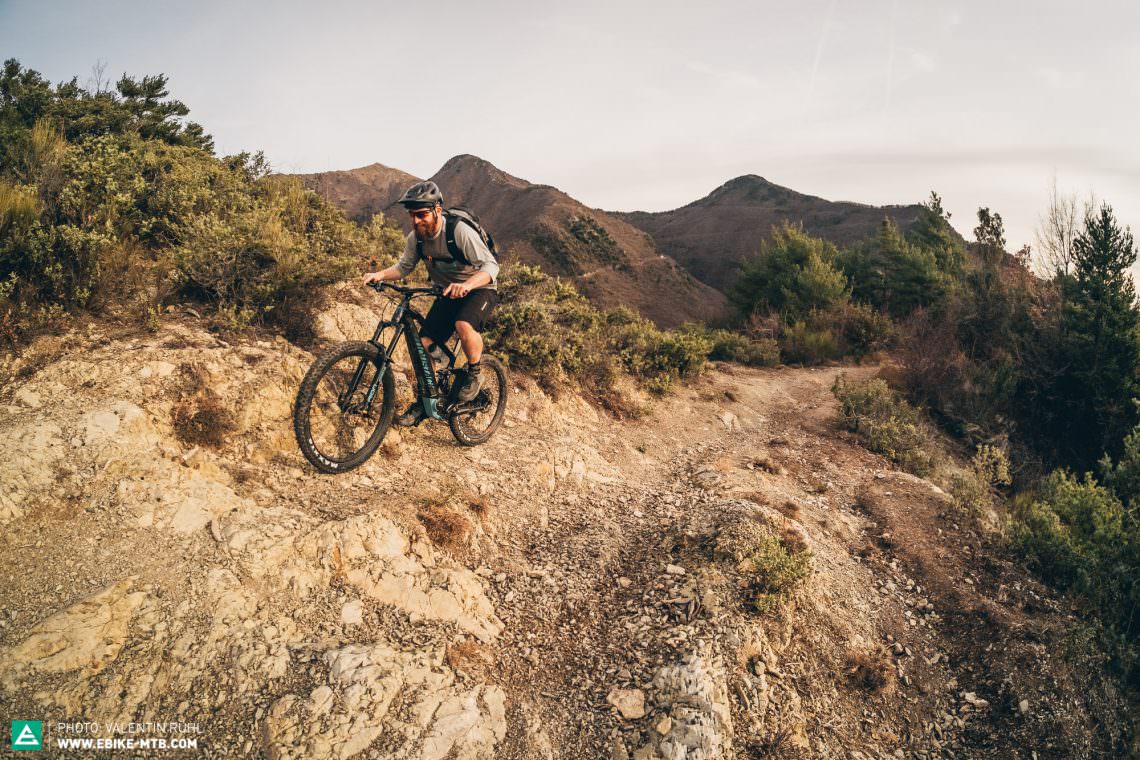
You don’t buy a car only because of its engine. An eMTB is about more than just the motor!
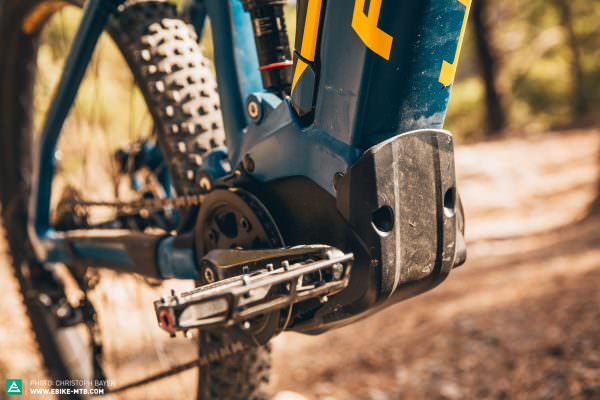

How much does a good eMTB weigh?
Due to high total weights of over 20 kg, it doesn’t matter whether the scale stops at 21.44 kg or 22.2 kg for a modern eMTB. In our test, the difference between the lightest and the heaviest bike was just under 4 kg. This is not to be ignored… but a little extra weight in the form of functional, reliable componentry is better than an ebike designed and constructed to be as light as possible, at all costs, but which ends up in the workshop more often than on the trail.
Integrated rechargeable batteries look nice…
…but currently offer only very few advantages, such as a cleaner design and the option to mount a bottle cage in the front triangle. If you want to take a spare battery in your backpack, you will have to struggle with the larger dimensions of the integrated batteries, or you won’t have the possibility to take one with you at all. Depending on the integration, handling the integrated rechargeable battery (e.g. the on-button for Shimano-Intube) can be awkward. Also, the longer battery results in a higher centre of gravity. The fact is that there are good reasons for continuing to use a standard external battery.
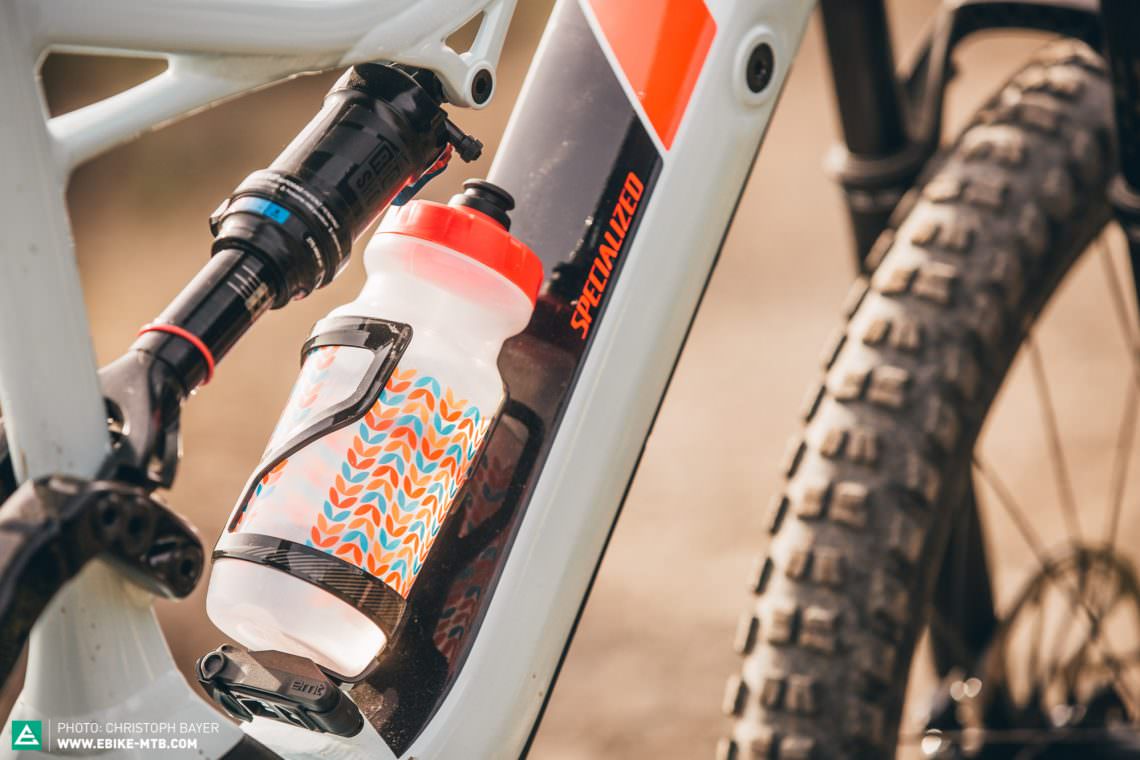
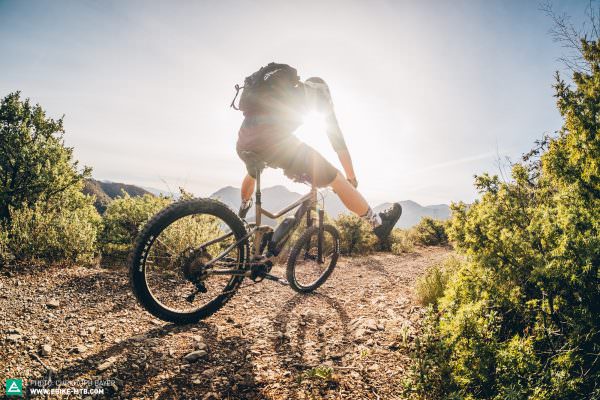

Wide tires – a plus in safety!
Wide tires are an absolute must on an eMTB. They offer more traction, provide extra comfort, increase stability, and they simply look cooler. Tires with a width of 2.5″ – 2.8″ have proven to be the ideal size. The performance of the MAXXIS Minion tires is particularly impressive; they provide the best grip and stability. To get the best performance, tires should be ridden at approx. 1.2 – 1.6 bar air pressure.
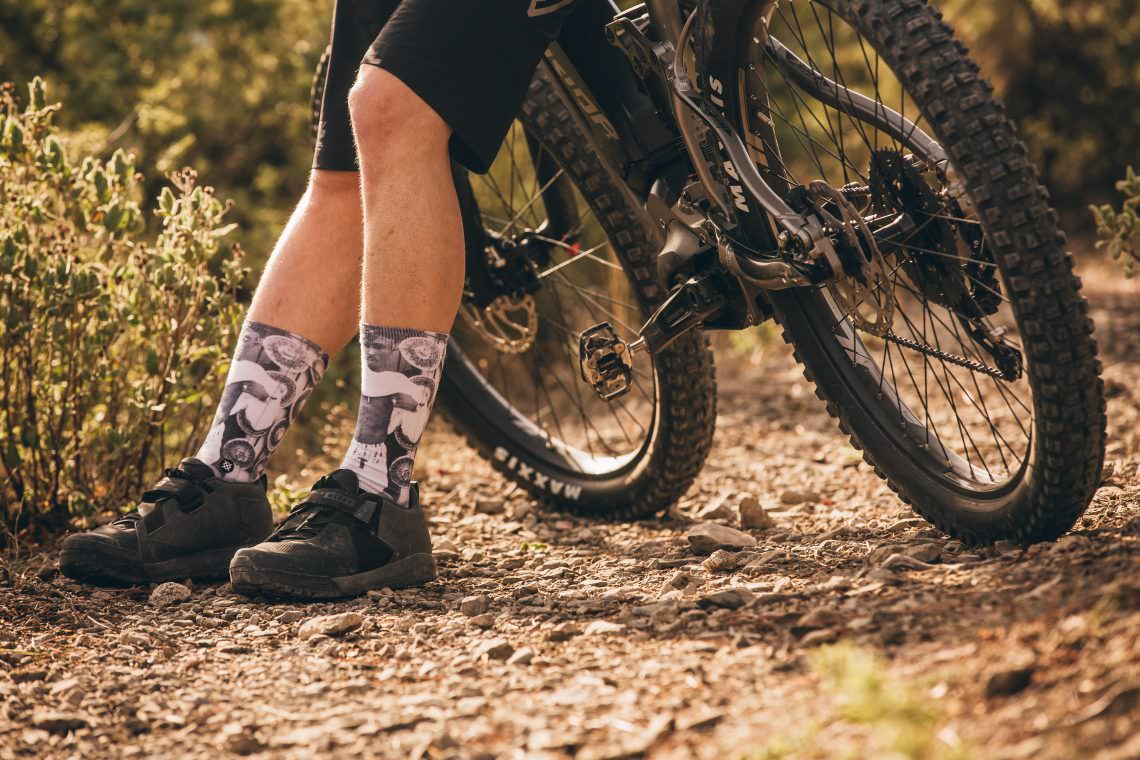
Good performance doesn’t have to be expensive
It’s probably the most important realization we had in this test: affordable eMTBs have never been better. The performance of the MERIDA eONE-SIXTY and CONWAY eWME 627 was particularly impressive. Both bikes are less than half the price of similar high-end bikes and have nothing to hide regarding handling, fun, and stability, as our group test on the following pages proves.

How do you find the perfect spec for an eMTB? The simplest solution would be to install only the best components. However, that’s not always possible when you’re on a budget. If a brand wants to sell its bikes at a favourable price point, brains and a willingness to compromise are required. Where can you save, and where is it worth investing a little more? An expensive drivetrain, for example, looks nice, though it hardly makes a difference on the trail. Key components include the suspension, wheels, tyres, brakes, and cockpit. The CONWAY eWME 627 and the MERIDA eONE-SIXTY 800 show how it’s done. The remaining test field made some significant errors.
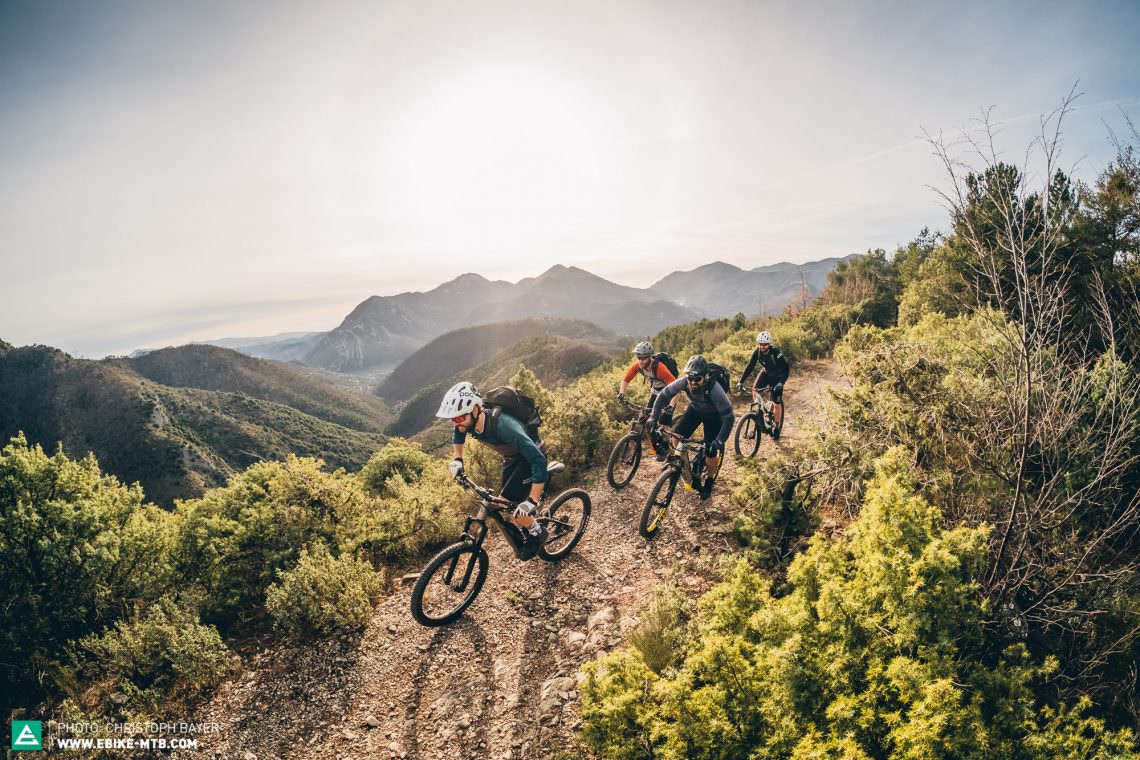
Bikes in test
| Bike | Price | Weight | Drivetrain | Battery |
|---|---|---|---|---|
| BULLS SIX50 EVO AM2 | € 4,399 | 25.22 kg | Bosch | 500 Wh |
| Conway eWME 627 | € 4,499 | 21.44 kg | Shimano | 504 Wh |
| FLYER Uproc4 4.10 | € 4,399 * | 24.92 kg | Panasonic | 630 Wh |
| FOCUS JAM² Plus | € 4,599 | 21.20 kg | Shimano | 378 Wh |
| Giant Full-E+ 1.5 Pro LTD | € 4,199 | 22.56 kg | Yamaha | 500 Wh |
| Haibike XDURO AllMtn 7.0 | € 4,499 | 25.52 kg | Bosch | 500 Wh |
| KTM MACINA KAPOHO 273 11 PT-CX5I | € 4,399 | 23.02 kg | Bosch | 500 Wh |
| MERIDA eONE-SIXTY 800 | € 4,599 | 21.86 kg | Shimano | 504 Wh |
| Moustache Samedi 27 Trail 6 | € 4,599 | 23.40 kg | Bosch | 500 Wh |
| SCOTT E-Genius 720 | € 4,799 | 24.22 kg | Shimano | 500 Wh |
| Specialized Turbo Levo FSR 6Fattie | € 4,199 | 22.69 kg | Brose/Specialized | 460 Wh |
* incl. battery- and dropper upgrade

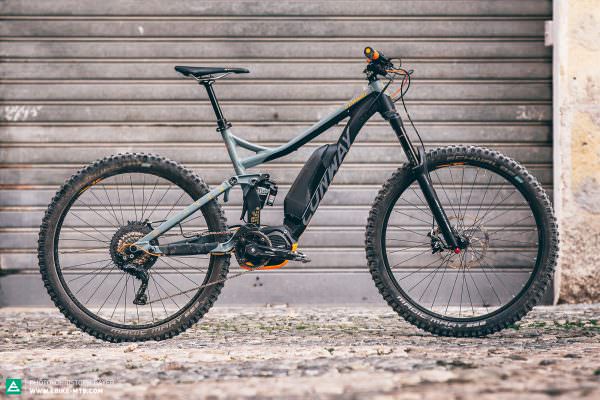
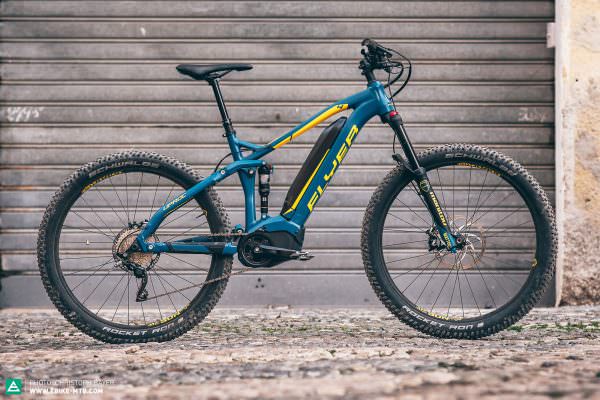
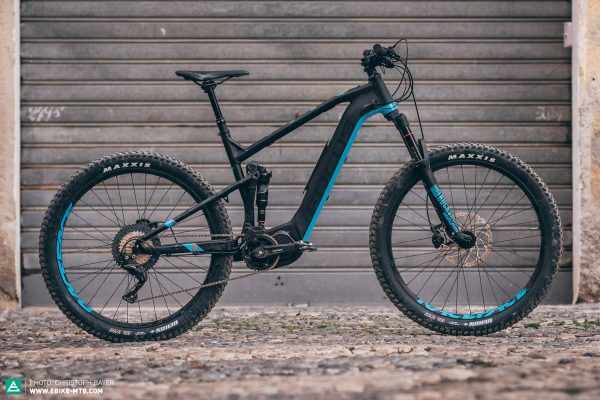

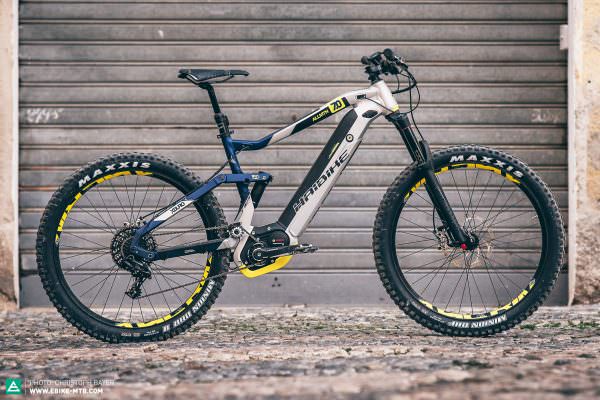
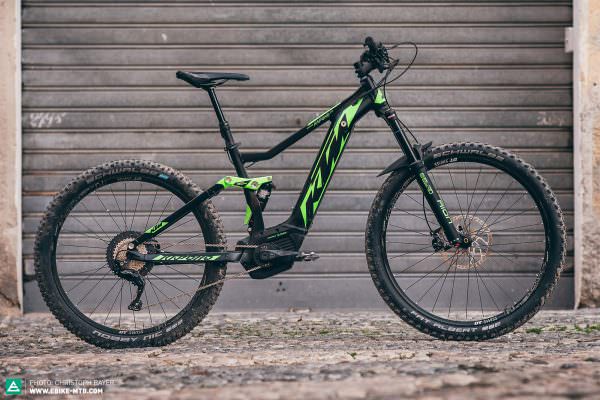
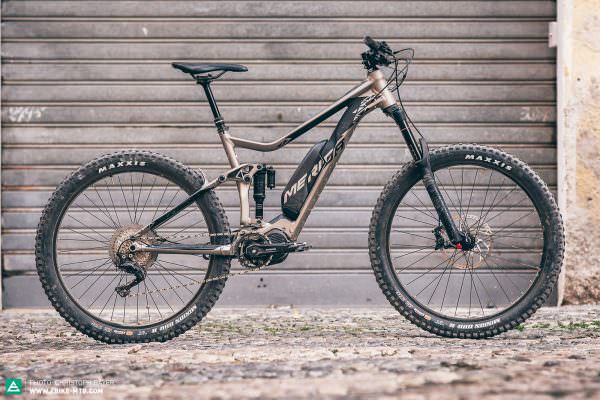

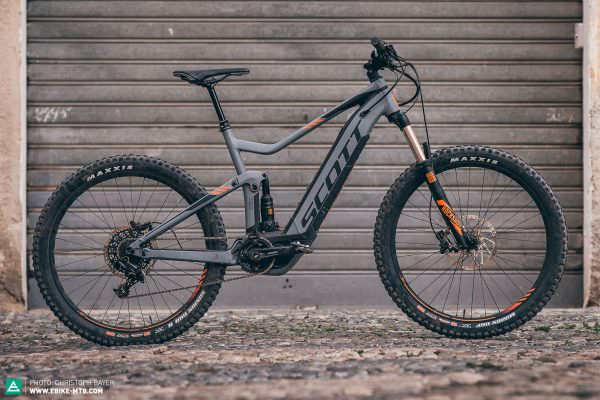

How many gears does an eMTB need?
The derailleur is already threatened by extinction on classic trail bikes, and ebikes should never actually have been introduced to them! This is evident in the Giant Full-E+ 1.5 Pro LTD. The chain rattles constantly, and a large overlap of gears requires shifting more often, which increases wear… and on top of that, the front derailleur doesn’t work under load, just when you really need it.
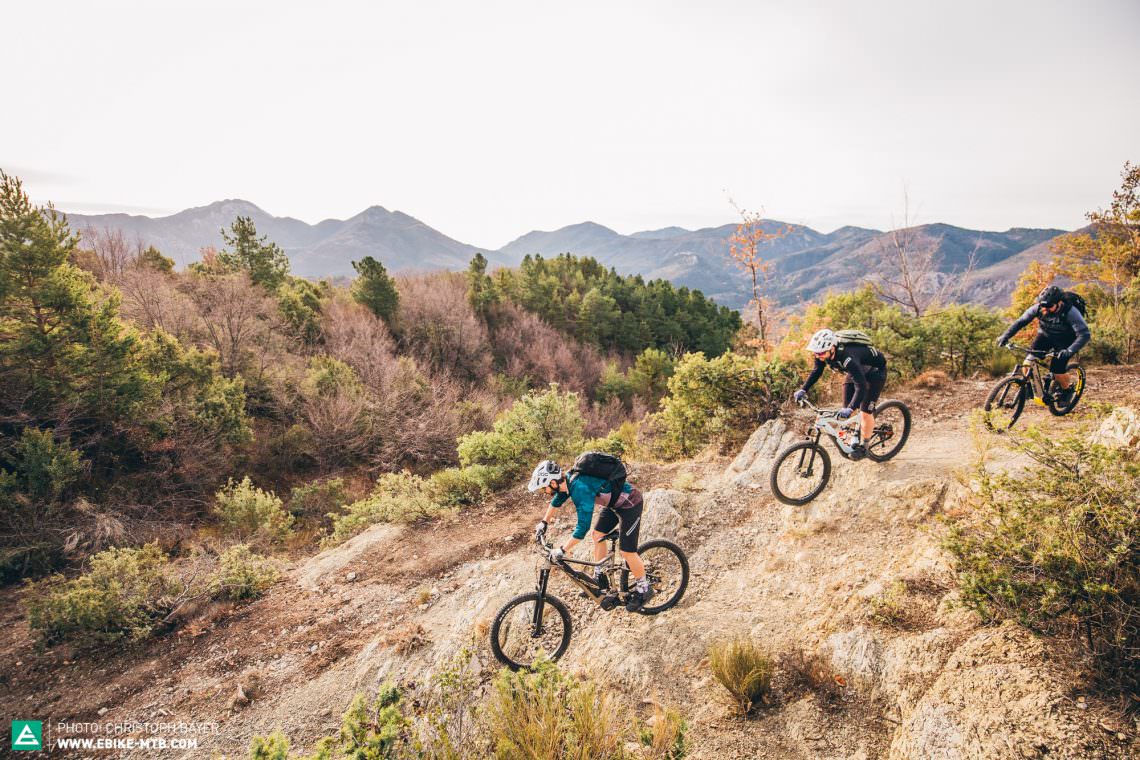
Extremely important: a dropper seatpost!
Anyone who believes a dropper seatpost which you can operate via a remote from the handlebar only makes sense on rough trails is mistaken. Even just stopping at traffic lights in the city, you’ll benefit from increased safety and comfort. On top of that, it makes getting on and off the bike easier. It is indispensable on an eMTB. Thus, it’s all the more regrettable that Specialized hasn’t specced them on the Levo FSR 6Fattie. At a price of € 4,199, however, you should have enough in your budget for an upgrade.
How much comfort can entry-level bikes offer?
Good news: when it comes to riding comfort, the manufacturers have done their homework. The seating position on all the bikes we tested is very comfortable and absolutely suitable for long distances. Upon buying, however, you should always have the contact points such as handlebar and saddle adjusted to your personal preferences.
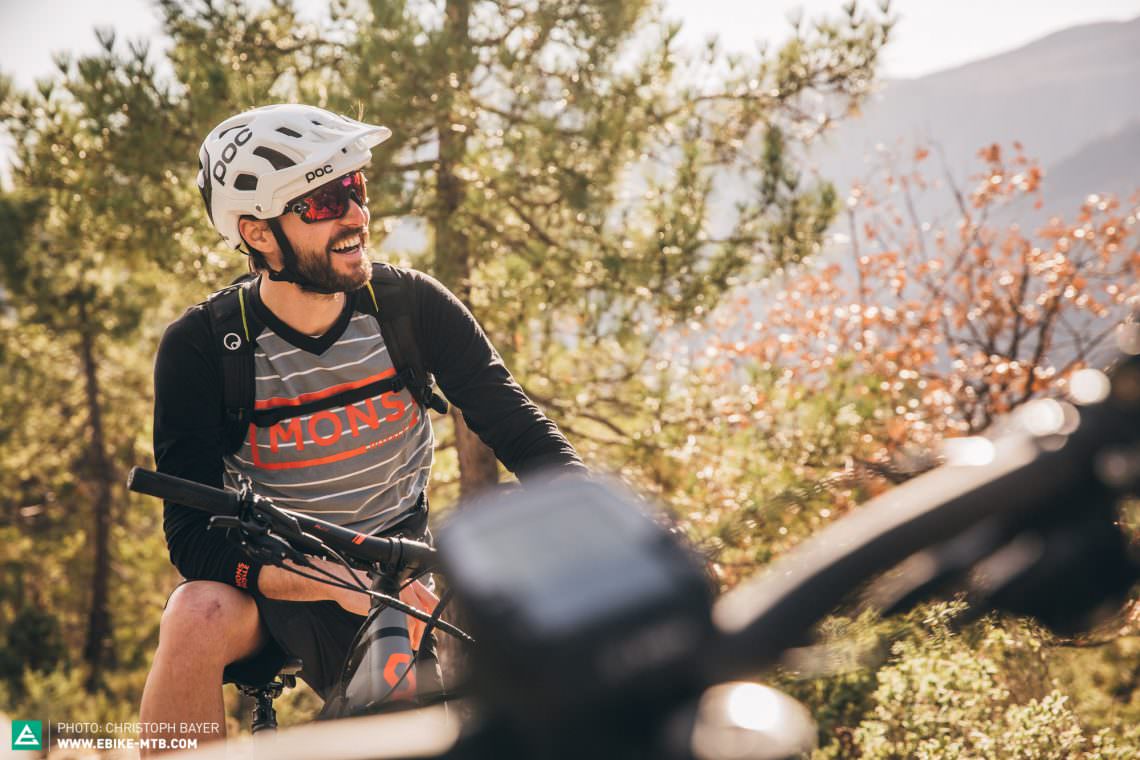
A good suspension fork is crucial
The fork is a point where several manufacturers in the test field tried to save. Only the Manitou Mattoc on the FLYER Uproc4 and the RockShox Yari on the Haibike XDURO AllMtn 7.0, the MERIDA eONE-Sixty 800, and the CONWAY eWME 627 managed to convince us. The other models are okay for use on forest roads and leisurely trails, but reach their limits as soon as the terrain becomes more demanding.
All the bikes were capable climbers
All the bikes in this group test are very efficient climbers, and thanks to their powerful motors, at the push of a button they’ll get you to the top without breaking a sweat. There are some important differences though. The Specialized Levo is the most potent climber with its new, powerful Brose motor and aggressive seating position, although it’s followed closely by the CONWAY eWME 627. But just to be clear: The other bikes in the test field won’t have any trouble getting you up the mountain either. The differences become particularly clear as the the trails become more technical. Here other factors besides the geometry begin to affect the bikes’ climbing performance, such as the grip of the tyres or the crank length.
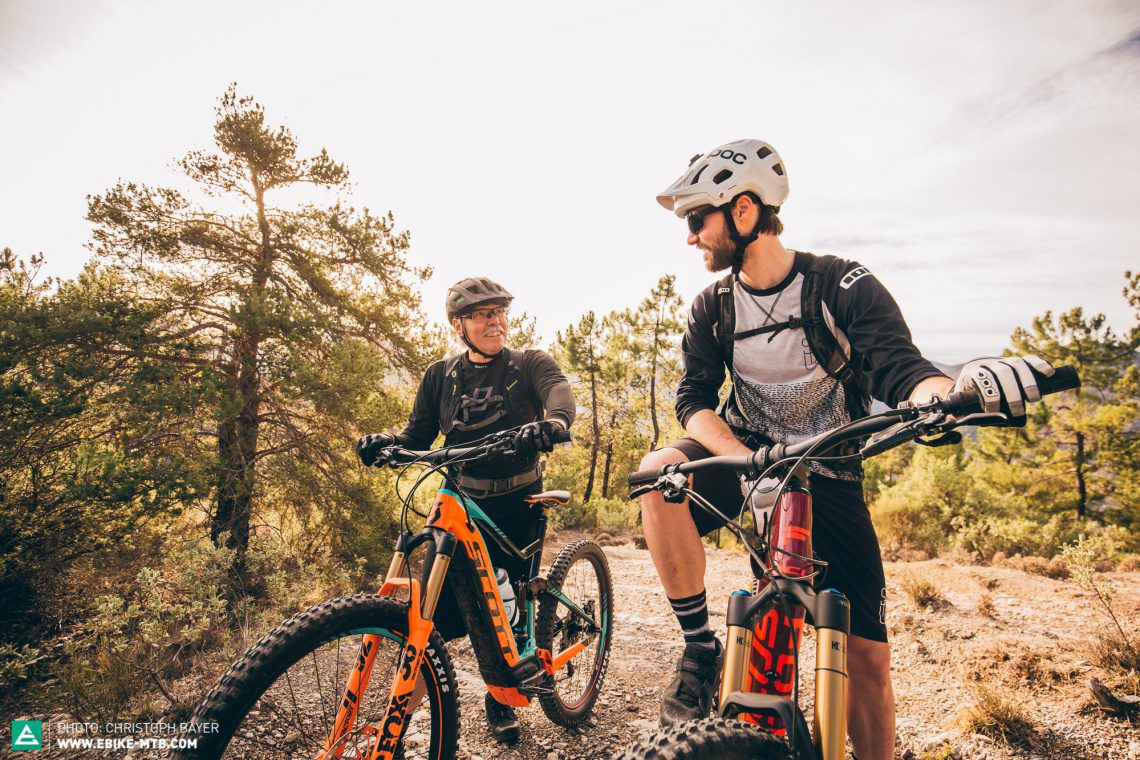
It’s all about the handling
The greatest art in the construction of an eMTB is to combine what may seem like contradictory riding characteristics into one bike. The best bikes are stable and composed, yet at the same time playful and agile. This test reveals clear differences. The Haibike XDURO AllMtn 7.0, the Giant Full-E+ 1.5 Pro LTD, and the Bulls SIX50 AM2 are significantly less agile than the other models. These three bikes literally stick to the ground and require you to really muscle them through tight corners. You won’t notice it on relaxed rides on forest roads, but those who like to ride a bit of singletrack will wish for more agility and more playful handling.
Tops & Flops
Often small details can make a huge difference: seamless integration, first-class ergonomics and carefully selected parts. Easier said than done – here are some of the tops and flops from this grouptest.
Tops
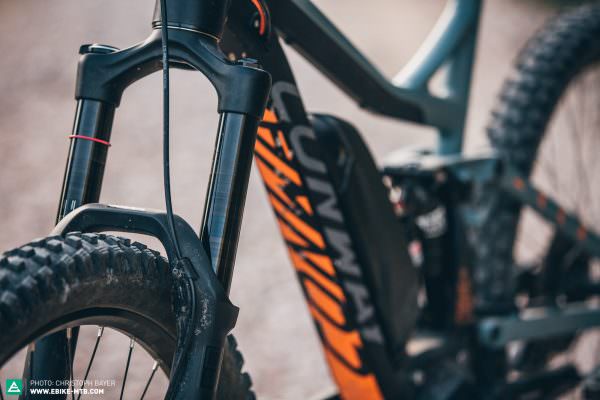
The RockShox Yari fork on the Haibike, CONWAY, and MERIDA is in a class of its own in this price segment.
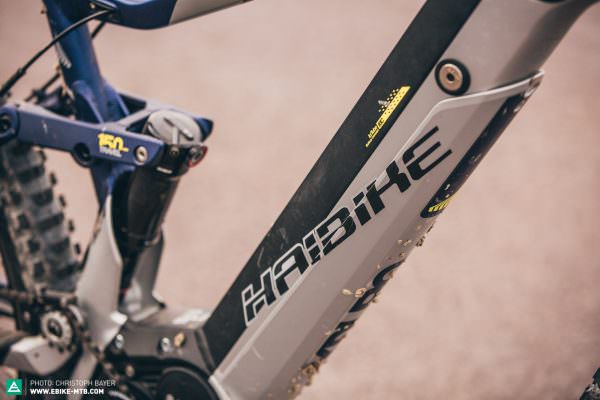
The integrated Bosch PowerTube battery lends the Haibike a slim silhouette and leaves space for a bottle cage
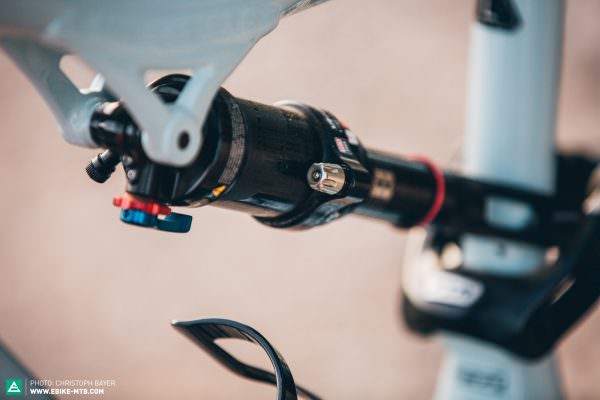
The Autosag valve makes setting up the shock a lot easier. It’s brilliant, especially for less tech-savvy riders
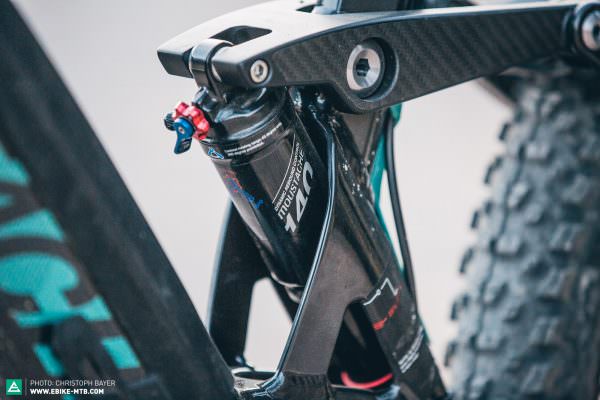
The specially developed shock on the Moustache inspires with a lot of traction and very good feedback
Flops
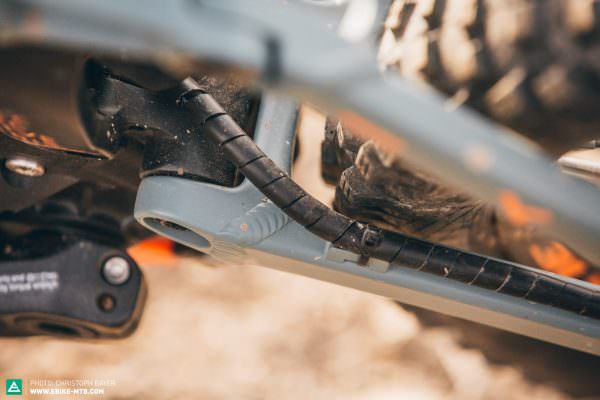
The rear end of the CONWAY is very tight on tyre clearance. It will inevitably get clogged up with mud and scratched.
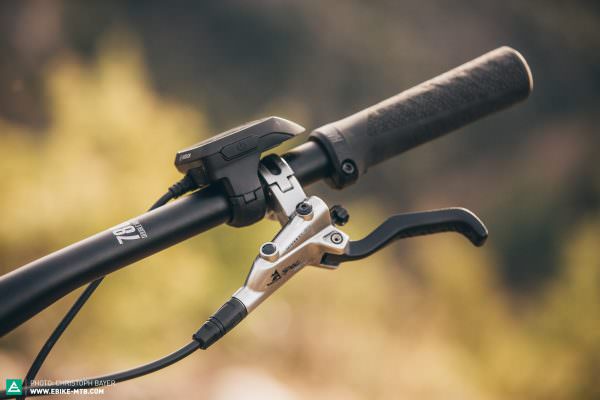
The TRP brakes on the Haibike lack power and modulation. To slow down the bike quickly, you’ll need strong fingers. Upgrade immediately!

The 2x drivetrain on the Giant Full-E+ 1.5 LTD is superfluous. The chain rattles, shifting is less accurate and reliable, and wear is increased.
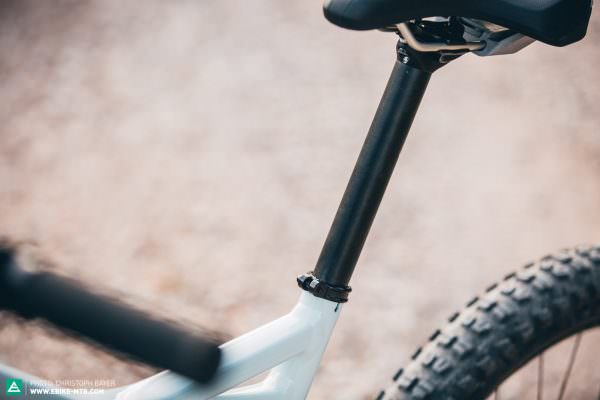
A dropper seatpost belongs on every eMTB. It not only increases the amount of fun you’ll have, but also your confidence, safety, and stability. Unfortunately, it’s missing on the Levo.
The best affordable eMTB
So which is the best eMTB for less than € 4,500? Unfortunately, the Giant Full-E+ 1.5 Pro LTD is out of the race due to its sluggish handling and the 2x drivetrain. The same applies to the Specialized Turbo Levo FSR 6Fattie, which, due to the missing dropper post and the weak brakes will end up costing you quite a bit extra for upgrades. The fact that the €9,999 Specialized Turbo Levo S-works won the high-end group test in the last issue goes to show that compromises in the spec on the cheaper models can result in huge losses regarding their performance on the trail. The Haibike XDURO AllMtn 7.0 was held back because of a noisy pulley wheel, weak brakes, and cumbersome handling. The BULLS SIX50 AM2 is particularly suitable for relaxed service-road tours, but its components are not up to the task of aggressive trail use. The FOCUS JAM² Plus offered very good handling, but it has the lowest battery capacity in the test field with 376 Wh. If you want more reach, you can retrofit the T.E.C. Pack, but you will have to fork out € 500, and also lose a large part of the bike’s agility.

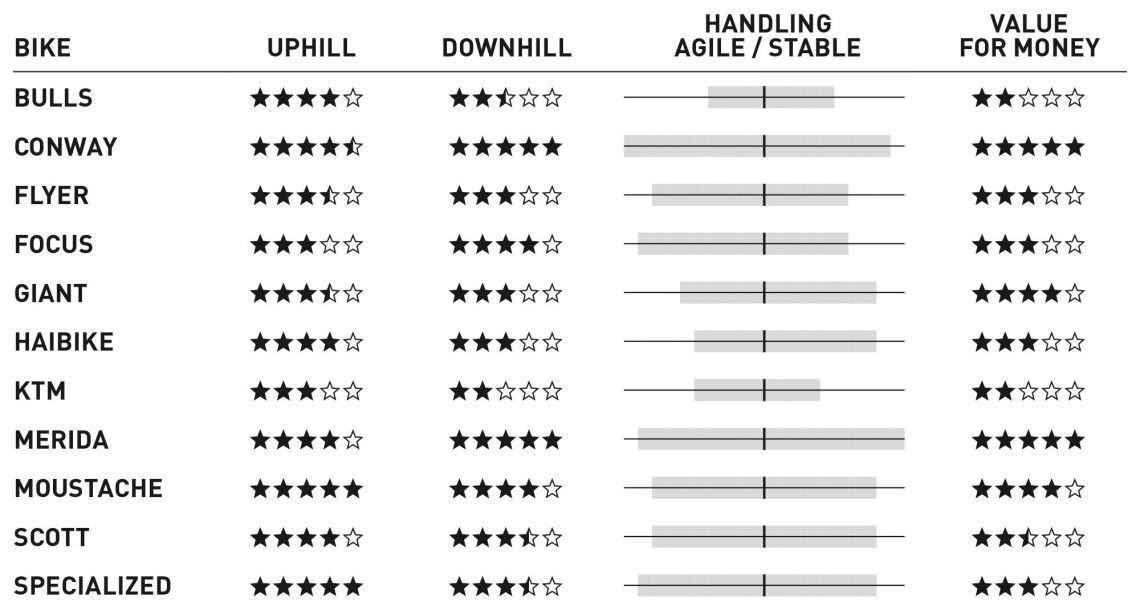
The basis of the FLYER Uproc4 6.30 is good, but some of the components, such as the tyres and brakes, do not live up to the potential of the bike. The SCOTT E-Genius 720 is similar: the attention to detail on the frame is great, but the entry-level fork prevents it from reaching its full potential. The concept of the KTM MACINA Kapoho is much less balanced. Despite a modern mix of wheels, the bike cannot keep up with the competition, whether it was going up or coming back down. The Moustache Samedi 27 Trail 6 is somewhat better, offering massive amounts of traction thanks to a specially developed shock. However, the entry-level fork it is specced with limits an otherwise outstanding bike in demanding terrain.
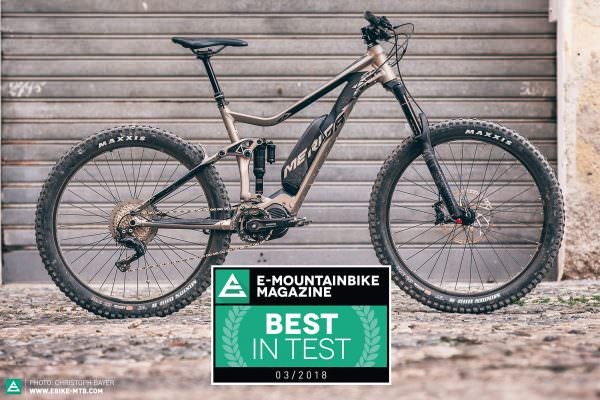
MERIDA eONE-SIXTY 800

Conway eWME 627
The CONWAY eWME 627 and the MERIDA eONE-SIXTY 800, therefore, are neck and neck on the final straight. Both bikes offer outstanding riding characteristics and can easily compete with significantly more expensive bikes from our high-end group test in issue #012. The CONWAY, with its very cleverly selected spec and low price, secures itself the Best Value tip. With significantly better workmanship, more stability, and more direct handling, the MERIDA eONE-SIXTY 800 claims the overall test victory once again.

All bikes in test: BULLS SIX50 EVO AM2 | Conway eWME 627 | FLYER Uproc4 4.10 | FOCUS JAM² Plus | Giant Full-E+ 1.5 Pro LTD | Haibike XDURO AllMtn 7.0 | KTM MACINA KAPOHO 273 11 PT-CX5I | MERIDA eONE-SIXTY 800 | Moustache Samedi 27 Trail 6 | SCOTT E-Genius 720 | Specialized Turbo Levo FSR 6Fattie
Did you enjoy this article? If so, we would be stoked if you decide to support us with a monthly contribution. By becoming a supporter of E-MOUNTAINBIKE, you will help secure a sustainable future for high-quality cycling journalism. Click here to learn more.
Words: Photos: Christoph Bayer, Valentin Rühl




